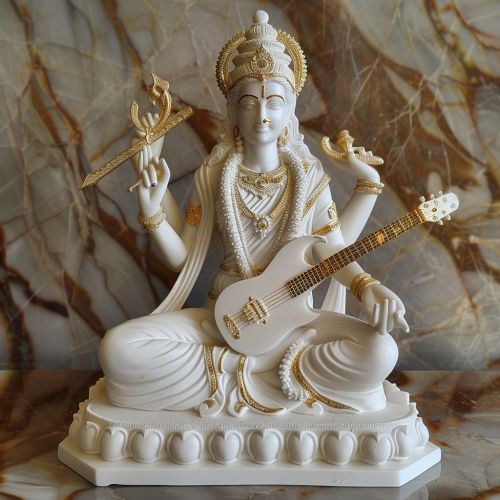Saraswati
Origins and History
Saraswati, the Hindu goddess of knowledge, music, art, wisdom, and learning, is a central figure in Hindu culture and religion. She is part of the trinity (Tridevi) of Saraswati, Lakshmi, and Parvati. All the three forms help the trinity of Brahma, Vishnu, and Shiva to create, maintain, and regenerate the Universe, respectively.
The earliest known mention of Saraswati as a goddess is in the Rig Veda. She has remained significant as a goddess from the Vedic period through modern times of Hindu traditions. Some Hindus celebrate the festival of Vasant Panchami (the fifth day of spring, and also known as Saraswati Panchami and Saraswati Puja) in her honour, and mark the day by helping young children learn how to write alphabets on that day.


Iconography and Symbolism
Saraswati is often depicted as a beautiful woman dressed in pure white, often seated on a white lotus, which symbolizes light, knowledge, and truth. She not only embodies knowledge but also the experience of the highest reality. Her iconography is typically in white themes from dress to flowers to swan – the colour symbolizing Sattwa Guna or purity, knowledge, and true understanding.
She is generally shown to have four arms, which represent the four aspects of human personality in learning: mind, intellect, alertness, and ego. Alternatively, these four arms also represent the 4 Vedas, the primary sacred books for Hindus. The Vedas, in turn, represent the 3 forms of literature:
1. Poetry — the Rigveda contains hymns, representing poetry. 2. Prose — Yajurveda contains prose. 3. Music — Samaveda represents music.
Worship and Festivals
The most significant Saraswati Puja festival is celebrated every year on the day of Vasant Panchami. According to the tradition of many Hindus, it is considered auspicious to learn something new or start education on this day. In some parts of India, particularly in the south, Saraswati Puja is celebrated during the Navaratri period.
Saraswati is also revered by believers of the Jain religion of west and central India, as well as some Buddhist sects. She is known in Burmese as Thurathadi or Tipitaka Medaw, in Chinese as Biàncáitiān, in Japanese as Benzaiten and in Thai as Suratsawadi or Saratsawadi.
Influence on Indian Culture
Saraswati's significance to Indian culture is more than just a symbolic representation of a goddess. She is a part of education, arts, and culture in ways that go far beyond religion. Many schools and educational institutions in India and the world have been named after Saraswati. Her iconic symbolism of knowledge and arts is often displayed in places of learning, arts, and culture.
